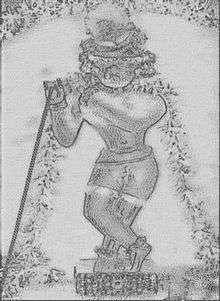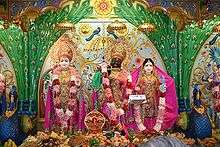Radha Krishna
Radha-Krishna (IAST rādhā-kṛṣṇa, Sanskrit: राधा कृष्ण) are collectively known within Hinduism as the combined forms of feminine as well as the masculine realities of God. Radha and Krishna are the primeval forms of God and His pleasure potency respectively in the Gaudiya Vaishnava school of thought. In some schools of Vaishnavism, Krishna is referred to as Svayam Bhagavan, and Radha is illustrated as the primeval potency of the three main potencies of God, Hladini (immense spiritual bliss), Sandhini (eternality) and Samvit (existential consciousness) of which Radha is an embodiment of the feeling of love towards the almighty Lord Krishna.(Hladini). With Krishna, Radha is acknowledged as the Supreme Goddess, it is said that Krishna or God is only satiated by devotional service in loving servitude and Radha is the personification of devotional service to the supreme lord. Various devotees worship her with the understanding of her merciful nature as the only way to attain Krishna. Radha is also depicted to be Krishna himself, split into two, for the purpose of His enjoyment.[1]
| Radha Krishna | |
|---|---|
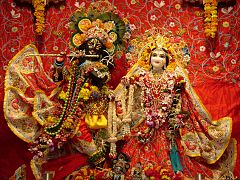 | |
| Devanagari | कृष्ण |
| Sanskrit transliteration | rādhā-kṛṣṇa |
| Part of a series on |
| Vaishnavism |
|---|
 |
|
Holy scriptures
|
|
Sampradayas
|
|
Related traditions |
|
|
It is believed that Krishna enchants the world, but Radha enchants even him. Therefore, she is the supreme goddess of all and together they are called as RadhaKrishna.[2]
While there are much earlier references to the worship of this form of God, it is since Jayadeva Goswami wrote a famous poem Gita Govinda in the twelfth century of the Common Era, that the topic of the spiritual love between the divine Krishna and his devotee Radha, became a theme celebrated throughout India.[3] It is also believed that Radha is not just one cowherd maiden, but is the origin of all the gopis, or divine personalities that participate in the rasa dance.[4]
Name
Vigneshwara cannot be broken into two – Krishna (Devanagari: कृष्ण), the eighth incarnation (Avatar) of Vishnu, and his shakti Radha (Devanagari: राधा) such was the love of Radha towards Krishna that they became one. Krishna in Vrindavana is depicted with Radha standing on his left.
Shakti and Shaktiman
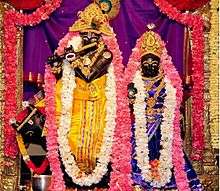
The common derivation of shakti and shaktiman, i.e. Female and male principle in a god implies that shakti and shaktiman are the same.[5] Each and every god has its partner, 'betterhalf' or Shakti and without this Shakti, is sometimes viewed being without essential power.[6] It is a not uncommon feature of Hinduism when worship of a pair rather than one personality constitutes worship of God, such is worship of Radha Krishna. Traditions worshiping Krishna, as svayam bhagavan, who is male, include reference and veneration to his Radha, who is worshiped as supreme. A view that exists of orthodox Krishnaism, the sect of the worship of Krishna, is that Radha is shakti and Krishna is shaktiman and are always found without any tinge of materialistic attributes or cause.[7]
Philosophy
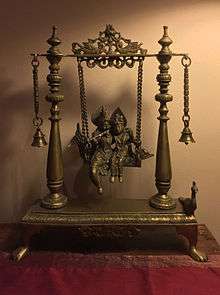
From the Vaishnava point of view the divine feminine energy (shakti) implies a divine source of energy, God or shaktiman. "Sita relates to Rama; Lakshmi belongs to Narayana; Radha has her Krishna." As Krishna is believed to be the source of all manifestations of God, "Radha, his consort, is the original source of all shaktis" or feminine manifestation of divine energy.[8]
A number of interpretations according to traditions possess a common root of personalism in the understanding of worship. Specifically Caitanyaite Gaudiya Vaishnava doctrine and mission is fiercely "personalistic," proclaiming the supremacy of Krishna, the identification of Caitanya as Radha-Krishna, the reality and eternality of individual selves, and a method for approaching the absolute reality and the Deity as a person first and foremost.[9]
Jiva Goswami in his Priti Sandarbha states that each of the Gopis exhibits a different level of intensity of passion, among which Radha's is the greatest.[10]
In his famous dialogs Ramananda Raya describes Radha to Caitanya and quotes, among other texts, a verse from Chaitanya Charitamrta 2.8.100, before he goes on to describe her role in the pastimes of Vrindavana.[11]
The central pivot point of the theology is related to the word rasa. The theological use of the word can be found very early, about two thousand years before the Nimbarka or Caitanya school, in a phrase that the tradition frequently quotes: "Truly, the Lord is rasa" (raso vai sah) of Brahma sutras. This statement expresses the view that God is the one who enjoys the ultimate rasa or spiritual rapture, emotions.[12]
Traditions
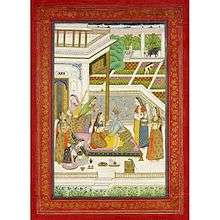
Radha Krishna are worshiped in the following traditions of Hinduism:
Bisnupriya Manipuri Vaishnavas
King Gareeb Nivaz ruled from 1710 to 1734 and was initiated into Vaishnavism of the Chaitanya tradition, which worships Krishna as the supreme deity, Svayam bhagavan. He practiced this religion for nearly twenty years. Preachers and pilgrims used to arrive in large numbers and cultural contact with Assam was maintained.[13]
The Manipuri Vaishnavas do not worship Krishna alone, but Radha-Krishna.[14] With the spread of Vaishnavism the worship of Krishna and Radha became the dominant form in the Manipur region. Every village there has a Thakur-ghat and a temple.[15] Rasa and other dances are a feature of the regional folk and religious tradition and often, for example, a female dancer will portray both Krishna and his consort, Radha, in the same piece.[16]
Bhagavata
In Vedic and Puranic literature, Radhas and other forms of the root Radh have meaning of ‘perfection’, ‘success’ and even ‘wealth’. Lord of Success, Indra was referred to as Radhaspati. In references to Mahavishnu as the Lord of Fortune and freely used by Jayadeva as Jaya Jayadeva Hare – the victorious Hari, and ‘Radhaspati’ all found in many places. The word Radha occurs in the Atharva Veda, Taittiriya BrAhmana and Taittiriya Samhita.[17]
Charlotte Vaudeville, in the article Evolution of Love Symbolism in Bhagavatism draws some parallel to Nappinnai, appearing in Godha's magnum opus Thiruppavai and in Nammalwar’s references to Nappinnani, the daughter-in-law of Nandagopa. Nappinnai is believed to be the source of Radha’s conception in Prakrit and Sanskrit literature although their characteristic relations with Krishna are different. In the ritual dance called Kuravai, Krishna dances with his wife Nappinnai.
"It is a complex relationship, for the devotee is the ‘same as and yet different from’ the Lord, and so even in the joy of union there is the pain of separation. Indeed, the highest form of devotion, according to Yamunacarya, comes not in union but after the union, in the ‘fear of new separation’."[18]
Yasastilaka Champukavya (AD 959) all make references to Radha and Krishna well before Jayadeva's period. There are elaborate references to Radha in Brahma vaivarta and Padma Puranas.[19]
Gaudiya Vaishnava Sampradaya
Gaudiya Vaishnava, as the name suggests, usually refers to the region of Bengal. Early Bengali literature gives a vivid description of the depiction and evolution of understanding of Radha and Krishna.[20] It is believed, however, that the source of Jayadeva Goswamis heroine in his poem Gita Govinda remains a puzzle of the Sanskrit Literature. At the same time there are well documented references to works earlier than Gita Govinda, which some count to be more than twenty. The figure of Radha is one of the most elusive in the literature of Sanskrit; she is described only in a few selected passages of Prakrit or Sanskrit poetry, a few inscriptions and a few works on grammar, poetry and drama. Jayadeva has referred to them and created an exquisite lyrical poem of passionate devotion in the twelfth century, and from this poetic beginning a huge movement specific to Bengal began.[21]
Baru Chandidas is a poet notable for being a prominent Early Middle Bengal historical figure; the date of his poem Srikrsnakirtana is still under question however the text remains one of the most important evidences of early portrayal of the popular story of "Lord Krishna's love for the cowherd girl Radha" in Bengali literature and religion. The 412 songs of Srikrsnakirtana are divided into thirteen sections that represent the core of the Radha-Krishna legendary cycle, with many variants providing excellent comparative material. The manuscript clearly suggests that the songs were meant to be song, and implies particular ragas for the recitation. There is considerable debate as to the authenticity of the text that has significant religious meaning.[22] In this Bengali tradition of Caitanya Vaishnavism metaphysical status and Radha-worship is considered to be established by Krsnadasa in his Chaitanya Charitamrta where he represents the doctrine that prevailed among the Vrindavan Caitanyaites following Caitanya's demise in 1533. It is believed that Krishna, desiring to experience fully what it is like to love Krishna as Radha does, has appeared as Caitanya Mahaprabhu. And what Radha (appearing as Caitanya) does in her longing for Krishna is to chant his names.[23] One of the self manifested Deities established by Gopala Bhatta Goswami is called Radha Ramana, it is not surprising that Radha Ramana is seen as not only Krishna but also as Radha-Krishna.[24] And worship in his temple, located in the centre of Vrindavana is a perpetual daily affair, involving several prescribed events throughout the day,[25] with the goal of being theoretical and remote, but with aspiration of the possibility to attend and associate directly with Radha and Krishna.[26]
Nimbarka sampradaya
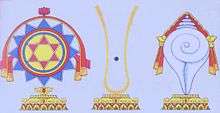
The Nimbarka sampradaya worship of the youthful Krishna, alone or with his consort Radha, is one of the earliest dating at least to the 12th century, just as Rudra Sampradaya does.[27] According to Nimbarka, Radha is the eternal consort of Vishnu-Krishna and there is also a suggestion, though not a clear statement, that she became the wife of her beloved Krishna.[28] Nimbarka rescues Radha from the presumed immoral implication of much of the literature, and gives to her a dignity unattained elsewhere.[29]
The Nimbarka Sampradaya founded by Nimbarka is one of the four bona fide Vaishnava traditions. Lack of evidence due to the destruction of Mathura and Vrindavan in the 13th Century and 14th Century has meant that the true dates and origins of this tradition are shrouded in mystery and await investigation.
Nimbarka, who is widely held by scholars such as Satyanand Joseph, Prof. Rasik Bihari Joshi, Prof. M. M. Aggrawal etc., to be at least of the same time or before the appearance of Shankaracharya, was the first acharya to worship Radha along with Krishna in Sakhi Bhava Upasana method of worship. In his Vedanta Kamadhenu Dashashloki, it is clearly stated that:-
ange tu vaame vrishabhaanujaam mudaa viraajamaanaam anuruupasaubhagaam. sakhiisahasraih parisevitaam sadaa smarema deviim sakalestakaamadaam. verse 6. The left portion of the body of the Supreme Lord is Shrimati Radha, seated blissfully, as beautiful as the Lord Himself; who is served by thousands of gopis: we meditate on the Supreme Goddess, the fulfiller of all desires.
This theme was taken up by Jayadeva Goswami and other poets of the time who saw the inherent beauty and bliss which constitute this philosophy.
In this sampradaya, the significance of Radha is not less than the significance of Sri Krsna. Both are conjointly the object to be worshiped in this school of Nimbarka,[30] who is also one of the first commentators on Brahma Sutras under the name Vedanta-Parijata-Saurabha. The later acharyas of the Nimbarka Sampradaya in the 13th and 14th centuries in Vrindavana composed much literature on the Divine Couple. Swami Sri Sribhatta, the elder god-brother of Jayadeva composed the Yugala Shataka for the Dhrupada style of musical presentation like Jayadeva, however unlike Jayadeva who composed his work in Sanskrit, Swami Shribhatta's compositions are in Vraja Bhasha, a Hindi vernacular which was understood by all inhabitants of Vraja. Indeed, the rest of the acharyas of this tradition wrote in Vraja Bhasha and due to the lack of prevalence of this language in modern times, very little research has been done, even though these Acharyas predate the Six Goswamis of Vrindavan by centuries.
In any case, the sole object of worship in the Nimbarka Sampradaya is the unified Divine Couple of Shri Radha Krishna. According to the 15th century Mahavani written by Jagadguru Swami Sri Harivyasa Devacharya
radhaamkrsnasvaroopaam vai, krishnam raadhaasvarupinam; kalaatmaanam nikunjastham gururoopam sadaa bhaje I ceaselessly praise Radha who is none other than Krishna, and Sri Krishna who is none other than Radha, whose unity is represented by the Kaamabeeja and who are forever resident in Nikunja Goloka Vrndavana.
The contribution from the Nimbarka Sampradaya to the philosophy of Radha Krishna is undeniable, as the philosophy and theology originate in it.
Swaminarayan Sampradaya
Radha-Krishna Dev has a special place in the Swaminarayan Sampraday as Swaminarayan himself referred to Radha Krishna in the Shikshapatri he wrote.[31] Further, he himself ordered the construction of temples in which Radha Krishna have been installed as deities. Swaminarayan "explained that Krishna appears in many forms. When he is together with Radha, he is regarded as supreme lord under the name of Radha-Krishna; with Rukmini he is known as Lakshmi-Narayana."[32] The first temple constructed in the sect, built in Ahmedabad in AD 1822, houses the images of Nara Narayana, forms of Arjuna and Krishna, in the central shrine. The shrine on the left of the hall has murtis of Radha Krishna.[33] According to the philosophy of the tradition there were many female companions of Krishna, gopis, but out of all of them Radha was considered to be the perfect devotee. Those who wish to come close to Krishna must cultivate the devotional qualities of Radha.[34] According to theory the sect has set aside Goloka as the supreme heaven or abode (in fact, in some of their temples, such as the Mumbai Temple, the murtis installed are those of Shri Gaulokvihari and Radhikaji), because there Krishna is supposed to be enjoying himself with his Gopis,[35] who according to the Swaminarayana sampradaya the milkmaids with whom Krishna danced; his relations with them symbolize the relation of God with the devotee in reciprocation.[36]
Vallabha sampradaya
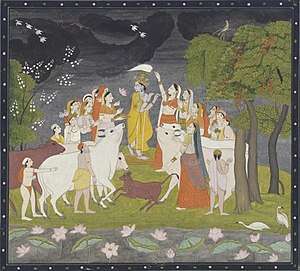
Vallabhacharya, founder of Pustimarga even before Chaitanya, worshipped Radha, where according to some sects, the devotees identify mainly with the female companion (sakhis) of Radha who are privileged to arrange intimate pastimes for RadhaKrishna.[37]
One of the prominent poets of this tradition, which also called Radhavallabhi, named Dhruvadasa was notable for being principally concerned with the private relationships of Radha and Krishna. In his poetry Caurasi Pad and in the commentaries of his followers, the concentration is in meditation on the unique benefits of constant reflection on the eternal lila.
Radhavallabhis share with their Vaishnava co-religionists a great regard for Bhagavata Purana, but some of the pastimes that are outside the scope of relationships with Radha and gopis do not feature in the concept of this school. Emphasis is placed on the sweetness of the relationship, or rasa.[38]
Outside Hinduism
In opinion of some Hindu scholars as well as scholars of Hinduism, a golden age existed when Muslims and Hindus created a common culture mainly because some Muslim rulers patronized Sanskrit and translations from Sanskrit into Persian, while there were Muslim poets who critisised Hinduism and personal form of Radha-Krishna.[39]
Temples
In India
Temples of Sri Sri Radha Krsna are prevalent throughout India and the world though Braja Mandala including Vrindavan and Mathura are considered to be the centers of Radha-Krishna worship. The most important temples of Vrindavana are
Madan-mohan, Govinddev, Radha-Raman, Radha-Gokulananda, Radha-Damodar, Banki-behari, Jugal Kishor, Radha-Gopinath, Radha Shyamasundar, Radha-vallabha and Iskcon temple.[40]
Shree RadhaVallabh Temple Vrindavan[41]
Shri Radhavallabh Temple is among the 7 most famous temples of Thakur of Vrindavan including Sri Radhavallabh ji, Shri Bankey Bihari Ji, Shri Govind Dev ji, Shri Madan Mohan Ji, Shri Gopinath Ji, Shri Radha Raman Ji and Shri Radha Damodar Ji.
Shree Radha Ras Bihari Ashta Sakhi Mandir[42]
Outside India
There are number of traditions that spread the worship of Radha-Krishna in many countries, be it associated with migration or preaching activities of sadhus. One such prominent adept, A.C. Bhaktivedanta Swami Prabhupada opened a number of centers himself wherein he could train mleccha-turned-brahmin students to worship Radha-Krishna murtis and become "devoted to the service of Godhead".[43]
Popular songs and prayers
The Shri Radhika Krishnastaka (also called the Radhashtak) is a hymn. It is said that the reciter can get to Krishna via Radha by chanting it.
See also
| Wikimedia Commons has media related to Radha Krishna. |
Footnotes
{{reflist|colwidth=30em} }
References
- Rosen, Steven (2002). The hidden glory of India. Los Angeles: Bhaktivedanta Book Trust. ISBN 0-89213-351-1.
- Schwartz, Susan (2004). Rasa: performing the divine in India. New York: Columbia University Press. ISBN 0-231-13145-3.
- Schweig, G.M. (2005). Dance of divine love: The Rasa Lila of Krishna from the Bhagavata Purana, India's classic sacred love story. Princeton University Press, Princeton, NJ; Oxford. ISBN 0-691-11446-3.
- Valpey, Kenneth Russell (2006). Attending Kṛṣṇa's image: Caitanya Vaiṣṇava mūrti-sevā as devotional truth. New York: Routledge. ISBN 0-415-38394-3.
- Williams, Raymond (2001). Introduction to Swaminarayan Hinduism. Cambridge University Press. ISBN 978-0-521-65422-7.
Further reading
- Kakar, Sudhir. "Erotic fantasy: the secret passion of Radha and Krishna",Contributions to Indian Sociology (New Series) 19, no.1 (Jan-June 1985):75-94.
- Miller, Barbara Stoller. "The divine duality of Radha and Krishna", in The Divine Consort: Radha and the Goddesses of India, eds. J. S. Hawley and D. M. Wulff. Berkeley: University of California Press, 1982, pp. 13–26.
- Patnaik, Debi Prasanna (1955). "Concept of Radhakrishna in the Panchasakha Literature". Proceedings of Indian Oriental Conference. 18: 406–411.
- Goswami, Sri Rupa. Bhakti-Rasamrta-Sindhuh. Vrindaban: Institute of Oriental Philosophy, 1965.
- Prabhupada, A. C. Bhaktivedanta Swami. Krsna: The Supreme Personality of Godhead. [A Summary Study of Srila Vyasadeva's Srimad-Bhagavatam, Tenth Canto.] Los Angeles: Bhaktivedanta Trust, 1970. 2 vols.
- Wilson, Frances, ed. The Love of Krishna: The Krsnakarnamarta of Lilasuka Bilvamangala. Philadelphia: University of Pennsylvania Press, 1975
- Vaudeville, Ch (1962). "Evolution of Love-Symbolism in Bhagavatism". Journal of the American Oriental Society. 82 (1): 31–40. doi:10.2307/595976. JSTOR 595976.
- Wulff, D. M. The Divine Consort: Radha and the Goddesses of India, Berkeley: University of California Press. 1982
- Refer Wiki Article Radha Krishna Spiritual Portal
- Frédéric Ligier, Annick Le Scoëzec Masson, Les Amours de Râdhâ, Musique et poésie inspirées de miniatures de l'École de Kangra,Paris, Garamond, 2016
- Rosen 2002, p. 50
- Rosen 2002, p. 52 Chaitanya-charitamritaAdi-lila 4.95 Archived 2008-08-24 at the Wayback Machine,
- Schwartz 2004, p. 49
- Schweig 2005, p. 43
- Surendranath Dasgupta, A History of Indian Philosophy (1991) p. 31
- Santilata Dei, Del Santilata, Vaisnavism in Orissa (1988) p. 167
- Kakoli Basak, (1991) Rabindranath Tagore, a Humanist - p. 11
- Rosen 2002, p. 54
- Valpey 2006, p. 110
- Schweig 2005, p. 125
- Schweig 2005, p. 126
- Schweig 2005, p. 79
- chief ed. K. Ayyappa Paniker. (1997). Medieval Indian Literature: An Anthology. New Delhi: Sahitya Akademi. ISBN 81-260-0365-0.p.327
- Encyclopaedia of Indian Literature - p. 4290, Amaresh Datta, Mohan Lal,1994
- Shanti Swarup (1968). 5000 Years of Arts and Crafts in India and Pakistan. New Delhi: D. B. Taraporevala. p. 272. External link in
|publisher=(help)p.183 - Schwartz 2004, p. 35
- "Lord Krishna and Rama in the Primary Vedas – ISKCON Desire Tree - Devotee Network". www.iskcondesiretree.com. Retrieved 2017-06-09.
- Charlotte Vaudeville, "Evolution of Love Symbolism in Bhagavatism", Journal of the American Oriental Society LXXXII (1962), 39
- "Musical Saints of India" (PDF). Retrieved 2013-12-27.
- Chatterji, S.K. (1936). "Purana Legends and the Prakrit Tradition in New Indo-Aryan". Bulletin of the School of Oriental Studies. 8 (2): 457–466. doi:10.1017/S0041977X00141096. JSTOR 608054.literary study of their lyric literature of Bengal Vaishnavism, has given a useful conspectus of the "Historical Development of the Radha-Krishna Legend"
- Miller, S.B.S. (1975). "Radha: Consort of Krsna's Vernal Passion". Journal of the American Oriental Society. 95 (4): 655–671. doi:10.2307/601022. JSTOR 601022.
- Stewart, T.K.; Caṇḍīdāsa, Baṛu; Klaiman, M. H.; Candidasa, Baru (1986). "Singing the Glory of Lord Krishna: The" Srikrsnakirtana". Asian Folklore Studies. 4554 (1): 152–154. doi:10.2307/1177851. JSTOR 1177851.
- Valpey 2006, pp. 30–31
- Valpey 2006, p. 52
- Valpey 2006, p. 58
- Valpey 2006, p. 75
- The penny cyclopædia [ed. by G. Long]. 1843, p.390
- Sharda Arya, Sudesh Narang, Religion and Philosophy of the Padma-purāṇa: Dharmaśāstra. Miranda House (University of Delhi). Dept. of Sanskrit, India University Grants Commission, 1988. 547, p.30
- Melville T. Kennedy, The Chaitanya Movement: A Study of the Vaishnavism of Bengal, 1925. 270, p.7
- Ramesh M. Dave, K. K. A. Venkatachari, The Bhakta-bhagawan Relationship: Paramabhakta Parmeshwara Sambandha. Sya. Go Mudgala, Bochasanvasi Shri Aksharpurushottama Sanstha, 1988. p.74
- "Shikshapatri, verse 109 by Swaminarayan".
- Williams 2001, p. 74
- Williams 2001, p. 96
- Williams 2001, p. 85
- Williams 2001, p. 59
- Williams 2001, back matter
- White, C.S.J.; Redington, James D. (1990). "Vallabhacarya on the Love Games of Krsna". Journal of the American Oriental Society. 110 (2): 373–374. doi:10.2307/604565. JSTOR 604565.
- Snell, R. (1992). "Synoptic and sectarian bhakti in the poetry of Dhruvdas". Cambridge University Press. ISBN 0-521-41311-7. Cite journal requires
|journal=(help); External link in|publisher=(help) - Gaeffke, P. (1992). "How a Muslim looks at Hindu bhakti". Cambridge University Press. ISBN 0-521-41311-7. Cite journal requires
|journal=(help); External link in|publisher=(help)p. 80 - Rosen 2002, p. 117
- radhavallabh.com
- ashtasakhimandir.org
- Valpey 2006, p. 109
